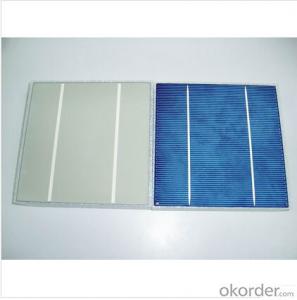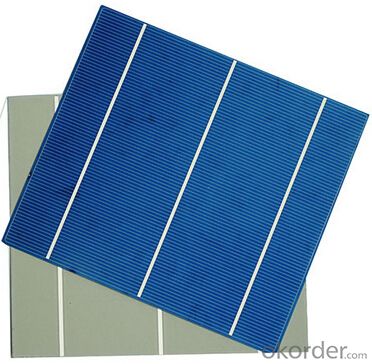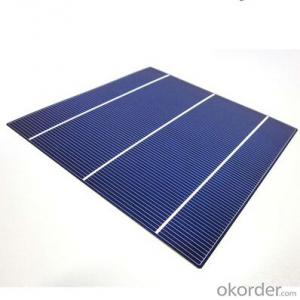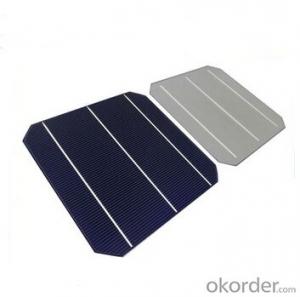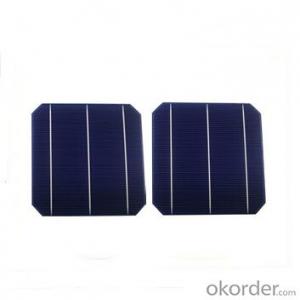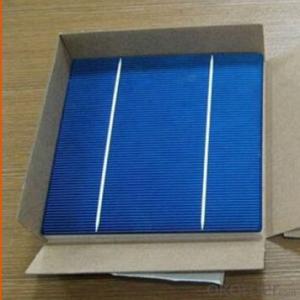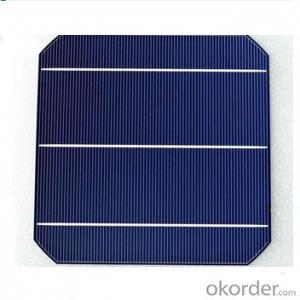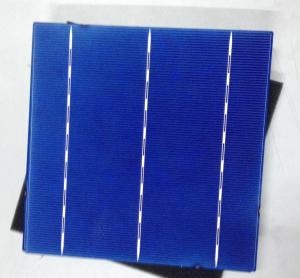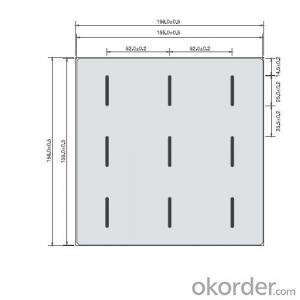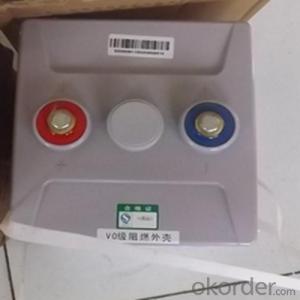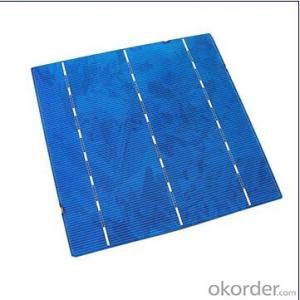LG Polycrystalline Solar Cells High Quality 17.40-19.20% Efficiency
- Loading Port:
- Shanghai
- Payment Terms:
- TT OR LC
- Min Order Qty:
- 1000 pc
- Supply Capability:
- 1000000 pc/month
OKorder Service Pledge
OKorder Financial Service
You Might Also Like
Solar Cells:
solar cells, when struck by photons of light from the sun, generates an electrical current which can then be used to power DC or AC electrical loads.
A solar cell is made of silicon. Computer chips are made of this same material. Basically, when light strikes the surface of a solar cell some of it is absorbed into the silicon. This light energy bumps the electrons loose and causes energy to flow
Solar cells is made by solar wafer, it has three categories of solar cell right now, monocrystalline polycrystalline and thin film,These cells are entirely based around the concept of PN junction, which is the critical part of solar module, it is the part that can convert the light energy into electricity, the thickness is from 180um to 200um, with even busbars to conduct electricity, textured cell can decrease diffuse reflection; they are often electrically connected and encapsulated as a module. Photovoltaic modules often have a sheet of glass on the front (sun up) side, allowing light to pass while protecting semiconductor wafers from abrasion and impact due to wind-driven debris, rain, hail, etc. Solar cells are also usually connected in series in modules, creating an additive voltage. Connecting cells in parallel will yield a higher current;With high quality and stable quality. Our Cells can greatly improve the performance of Solar Modules.
Specifications
Format | 52x78mm±0.5mm |
Diameter | 220±0.5mm |
Thickness | 200±20um |
Weight | 2±0.5g |
Front(-) | 1.8mm bus bars (Silver) |
Blue anti-reflecting coating (Silicon nitride) | |
Back (+) | 3mm wide soldering pads (Silver) |
Back surface field (aluminum). |
Efficiency code | 1720 | 1740 | 1760 | 1780 | 1820 | 1840 | |
Efficiency (min) | (%) | 17.2 | 17.4 | 17.6 | 17.8 | 18.2 | 18.4 |
Pmax | (W) | 4.186 | 4.234 | 4.283 | 4.332 | 4.429 | 4.478 |
Voc | (V) | 0.631 | 0.632 | 0.634 | 0.636 | 0.640 | 0.642 |
Isc | (A) | 8.446 | 8.485 | 8.523 | 8.573 | 8.660 | 8.700 |
Vmp | (V) | 0.525 | 0.527 | 0.529 | 0.531 | 0.535 | 0.537 |
Imp | (A) | 7.973 | 8.035 | 8.097 | 8.160 | 8.280 | 8.340 |
Solar Cells Advantage:
• High efficiency and stable performance in photovoltaic conversion.
• Advanced diffusion technique ensuring the homogeneity of energy conversion efficiency of the cell.
• Advanced PECVD film forming, providing a dark blue silicon nitride anti-reflection film of homogenous color and attractive appearance.
• High quality metal paste for back surface and electrode, ensuring good conductivity, high pulling strength and ease of soldering.
• High precision patterning using screen printing, ensuring accurate busbar location for ease with automatic soldering a laser cutting.
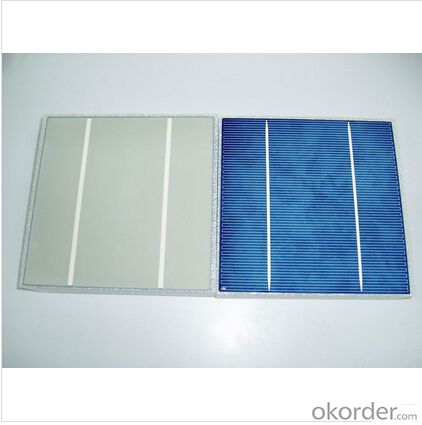
FAQ
We have organized several common questions for our clients,may help you sincerely:
①What price for each watt?
It depends on the efficiency of the solar cell, quantity, delivery date and payment terms.
②How long can we receive the product after purchase?
In the purchase of product within three working days, We will arrange the factory delivery as soon as possible. The pecific time of receiving is related to the state and position of customers.Commonly 7 to 10 working days can be served.
③Can you provide the peripheral products of the solar panels, such as the battery, controller, and inverter? If so, can you tell me how do they match each other?
Yes, we can, we have two companies for solar region, one is CNBM International, the other is CNBM engineering Co.
We can provide you not only the solar module but also the off grid solar system, we can also provide you service with on grid plant.
④What is your warranty of solar cell?
Our product can promise lower than 0.3% open box crack, we support claim after opening the box if it has crackm color difference or sth, the buyer should give pictures immediately, we can not accept the claim after the solar cell has assembled to solar panel.
• Timeliness of delivery
• ⑤How do you pack your products?
We have rich experience on how to pack the solar cell to make sure the safety on shipment, we could use wooden box or pallet as buyer's preference.
- Q: What is the maintenance required for solar cells?
- The maintenance required for solar cells is typically minimal. It involves regular cleaning of the solar panels to remove any dust or debris that may accumulate and potentially reduce their efficiency. Additionally, periodic inspections are recommended to detect any signs of damage or wear, such as cracked glass or loose connections, which should be repaired promptly. Overall, proper maintenance ensures optimal performance and longevity of solar cells.
- Q: What is a thin-film solar cell?
- A thin-film solar cell is a type of solar cell that is made using very thin layers of semiconductor materials. These layers are typically only a few micrometers thick, which makes the solar cell much lighter and more flexible compared to traditional solar cells. Thin-film solar cells are less efficient at converting sunlight into electricity but are more cost-effective and can be used in a wider range of applications.
- Q: Can solar cells be used for aerospace applications?
- Yes, solar cells can be used for aerospace applications. They are commonly used in spacecraft and satellites to harness solar energy and provide power for various systems and instruments. Solar cells are lightweight, compact, and highly efficient, making them ideal for aerospace applications where weight and space are crucial considerations.
- Q: Can solar cells be used in public infrastructure projects?
- Yes, solar cells can be used in public infrastructure projects. Solar cells can be integrated into various infrastructure elements such as street lights, bus stops, parking meters, and even road surfaces to generate electricity from sunlight. This sustainable energy source can help reduce reliance on traditional power grids, lower carbon emissions, and promote renewable energy use in public spaces.
- Q: What is the cost of producing a solar cell?
- The cost of producing a solar cell can vary depending on various factors such as the type and quality of materials used, manufacturing processes, scale of production, and market conditions. However, advancements in technology and economies of scale have significantly reduced the cost of solar cell production over the years. On average, the cost of producing a solar cell can range from a few cents to a few dollars per watt.
- Q: How does the solar panel produce it yourself?
- Step 4: Add Electrolytes Use iodine-containing solutions as the electrolyte for solar cells, which are mainly used for the reduction and regeneration of fuels. One or two drops of electrolyte can be added to the surface of the titanium dioxide film.
- Q: Can solar cells be used for powering wildlife tracking devices?
- Yes, solar cells can be used for powering wildlife tracking devices. Solar cells convert sunlight into electrical energy, which can be stored in batteries and used to power various devices, including wildlife tracking devices. This allows for continuous and sustainable power supply, eliminating the need for frequent battery replacements or recharging.
- Q: Can solar cells be used in desert areas?
- Yes, solar cells can be used in desert areas. In fact, desert areas are considered ideal locations for solar power generation due to their high solar radiation levels and vast open spaces. The availability of ample sunlight ensures efficient energy production by solar panels, making them a viable and sustainable option for generating electricity in desert regions.
- Q: Can solar cells be used in weather monitoring systems?
- Yes, solar cells can be used in weather monitoring systems. Solar cells can convert sunlight into electrical energy, which can power various weather monitoring instruments such as sensors, data loggers, and communication devices. This allows for a self-sustaining and environmentally friendly operation of weather monitoring systems, even in remote or off-grid locations. Additionally, solar cells can be integrated into the design of weather stations or buoys, enabling continuous power supply for uninterrupted data collection and transmission.
- Q: Can solar cells be used to power homes?
- Yes, solar cells can be used to power homes. Solar photovoltaic (PV) systems convert sunlight into electricity, which can then be used to power various appliances and lighting in households. These systems typically consist of solar panels installed on rooftops or other sunny areas, along with inverters and batteries to store excess energy for use during non-sunny periods or at night. With advances in technology and decreasing costs, solar power has become an increasingly viable and sustainable option for homeowners to generate their own electricity.
Send your message to us
LG Polycrystalline Solar Cells High Quality 17.40-19.20% Efficiency
- Loading Port:
- Shanghai
- Payment Terms:
- TT OR LC
- Min Order Qty:
- 1000 pc
- Supply Capability:
- 1000000 pc/month
OKorder Service Pledge
OKorder Financial Service
Similar products
Hot products
Hot Searches
Related keywords
